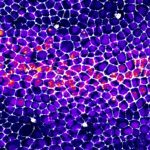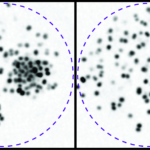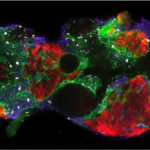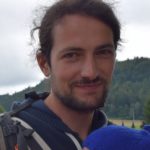Cancerous cells can expand in our tissues by killing neighbouring healthy cells. Researchers in Institut Pasteur, CNRS and the Université Paris Cité found a new mechanism used by cancerous cells to kill their neighbours by corralling and squeezing them up to death through a contractile belt.
Epithelia are one of the most common tissues in the human body. Their primary function is to separate organs, maintain their shape and protect them from infections and variations of the environment. The majority of human tumours (roughly 90%) arise from epithelium after the accumulation in a subset of cells of mutations that promote cell growth, cell survival and eventually the invasion of other tissues. Despite decades of work on cancer, the early phases of tumour progression that connect the appearance of few abnormal cells to the formation of a clinically detectable tumour mass remains poorly understood. It was previously proposed that some mutations associated with cancers could give a competitive advantage to a subset of cells that overgrow, compacting neighbouring cells and triggering their elimination, hence releasing space to facilitate their own expansion. However, it was unclear whether such mechanism could be generalised to other mutations associated with cancer, and whether cancerous cell overgrowth was the sole contributors to neighbouring cell elimination.
Squeezing the cells through a contractile belt
Researchers from the Institut Pasteur, the CNRS and Université Paris Cité just discovered a new mechanism where cancerous cells corral their neighbours and squeeze them up to death through a contractile belt. This work was just published in the journal Current Biology1. This discovery was obtained in the thorax epithelium of the fruitfly Drosophila. “This little fly is an ideal system to understand the mechanisms of interactions between cancerous cells and their environment. Mutations commonly found in human tumours can be easily generated in subset of cells and image for long time scales to probe their evolution” says Dr Romain Levayer, corresponding author of this study. By imaging the expansion of groups of cells expressing a mutation activating the gene Ras, a mutation commonly found in human tumours, the group found a striking tendency of the groups of Ras cells to change their shape and progressively round up. “The tendency of two cell populations to minimize their surface of contact is similar to the process happening between water and oil” says Dr. Léo Valon, co-first author of the study. What happens in these cells that prevent their mixing ? The group found that this was driven by an increase of the tension at the boundary between the two populations. “This progressive increase of tension also generates a local pressure that will compact and kill cells, especially at interfaces with high curvature. When cancerous cells surround groups of healthy cells, it looks like they squeeze a belt around them that progressively kill them” said Dr. Léo Valon.
Sorting out the contribution of growth and belt contraction
It became clear that several mechanisms (namely growth and belt-driven compression) could contribute to the killing of neighbouring cells, but how to disentangle these two processes ? “That’s where modelling becomes very useful” said Dr. Alexis Matamoro-Vidal, co-first author of the study. “We use a vertex model, a type of modeling commonly use to describe the evolution of epithelial cells, to explore the characteristic features of cell deformation triggered by overgrowth of cancerous cells or by contraction of their interface” said Dr. Alexis Matamoro Vidal. Doing so, the researchers outline several clear distinctive features related to cell deformation and the localisation of dying cells which help to differentiate the contribution of these two modes of competition.
Different flavours of competition in different mutations
Going back to the fly tissue, they then test various mutations found in tumours and could distinguish some where growth dominates the squeezing, while the contribution of the contracting belt dominates in other. “This was the first clear indication that different mechanisms can co-exist and contribute to healthy cells compression and their elimination near tumoural cells’” said Dr. Romain Levayer. Beyond this characterisation, how could we move forward to define new strategies to prevent tumour expansion ? “Our work suggests that molecules modulating the mechanical properties of the interface between cancer and healthy cells could have an important impact on tumour evolution” confirmed Dr. Romain Levayer. In that regard, it will be essential in the near future to better understand the molecular mechanisms that regulate the formation of this contractile belt. “None of this work would have been possible without the power of fly genetics, the possibility to extract quantitative numbers from long term microscopy movies and the prediction of modelling and physics” emphasise Dr. Léo Valon and Dr. Alexis Matamoro-Vidal. Clearly, the little fly still has a lot to teach us to probe new avenues to understand human pathologies.
- Interfacial tension and growth both contribute to mechanical cell, Current Biology, October 9th, 2025. doi: 10.1016/j.cub.2025.09.040
Léo Valon1*, Alexis Matamoro-Vidal1*, Alexis Villars1,2 and Romain Levayer1§
1. Department of Developmental and Stem Cell Biology, Institut Pasteur, Université de Paris Cité, CNRS UMR 3738, 25 rue du Dr. Roux, 75015 Paris, France
2. Current address: Department of Biosystems Science and Engineering, ETH Zürich, Schanzenstrasse 44, 4056 Basel, Switzerland
* These authors contribute equally to this work
§ Lead contact, correspondance to: romain.levayer@pasteur.fr








